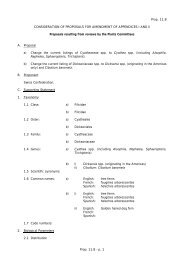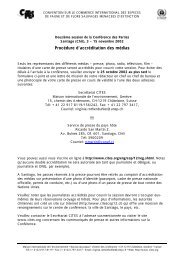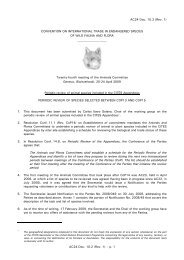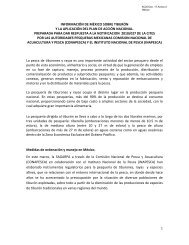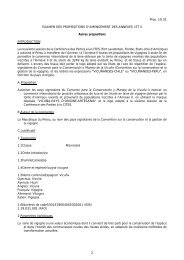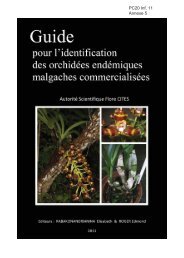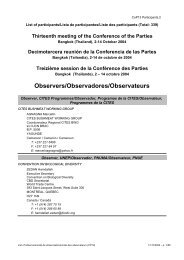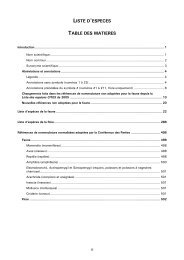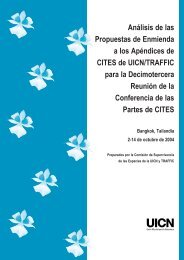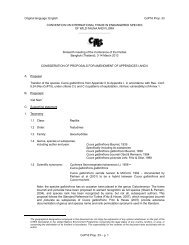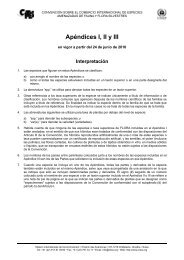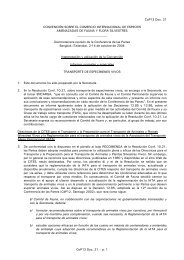Lamna nasus - Cites
Lamna nasus - Cites
Lamna nasus - Cites
You also want an ePaper? Increase the reach of your titles
YUMPU automatically turns print PDFs into web optimized ePapers that Google loves.
Draft Proposal to list <strong>Lamna</strong> <strong>nasus</strong> in Appendix II - prepared by Germany in January 2012<br />
(Conservation Measure 32-18; CCAMLR 2006). The Western and Central Pacific Fisheries Commission<br />
(WCPFC) will be responsible for pelagic shark management, but this is unlikely to be attempted during the<br />
early years of this Commission (Ministry of Fisheries 2006). Argentina requires live bycatch of large sharks to<br />
be released alive. Australia introduced legislation in 1991 preventing Japanese longliners fishing in the EEZ<br />
from landing shark fins unless accompanied by the carcass. They have not fished in the Australian EEZ since<br />
1996. Finning is prohibited in domestic Australian tuna longliners. New Zealand has included L. <strong>nasus</strong> in its<br />
Quota Management System (QMS) since 2004 with an unrestrictive TAC set at 249t (Sullivan et al. 2005),<br />
permitting finning and discard of carcasses.<br />
8.2 Population monitoring<br />
Routine monitoring of catches, collection of reliable data on indicators of stock biomass and good knowledge<br />
of biology and ecology are required. Most States do not record shark catch, bycatch, effort and discard data at<br />
species level or undertake fishery-independent surveys, preventing stock assessments and population<br />
evaluation. High seas catches are particularly poorly monitored (e.g. Campana and Gibson 2008). FAO<br />
FISHSTAT data are incomplete. Accurate trade data provide a means of confirming landings and an<br />
indication of compliance with catch levels, allow new catching and trading States to be identified, and provide<br />
information on trends in trade (Lack 2006). Trade data for porbeagle are, however, unreported except in the<br />
EU. FAO (2010) noted that a CITES listing is expected to result in better monitoring of catches entering<br />
international trade from all stocks and could therefore have a beneficial effect on the management of the<br />
species in all parts of its range. In the absence of a CITES listing there is no reliable mechanism to track<br />
trends in catch and trade of this species.<br />
8.3 Control measures<br />
International<br />
Other than sanitary regulations related to seafood products and measures that facilitate the collection of import<br />
duties, there are no controls or monitoring systems to regulate or assess the nature, level and characteristics of<br />
trade in L. <strong>nasus</strong>.<br />
Domestic<br />
The domestic fisheries management measures adopted by a few States described above cannot deliver<br />
sustainable harvest of L. <strong>nasus</strong> when stocks are exploited by several fleets, particularly in unregulated and<br />
unmonitored high seas fisheries. Even where catch quotas have been established, no trade measures prevent<br />
the sale or export of landings in excess of quotas. Otherwise, only the usual hygiene regulations apply to<br />
control of domestic trade and utilisation. STECF (2006) noted that although a CITES Appendix II listing<br />
alone would not be sufficient to regulate catching of porbeagle, it could be considered an ancillary measure.<br />
8.4 Captive breeding and artificial propagation<br />
No specimens are known to be bred in captivity.<br />
8.5 Habitat conservation<br />
Research in areas fished by the Canadian and French fleets and the results of tagging studies have identified<br />
some important L. <strong>nasus</strong> habitats, both within EEZs and on the high seas. Some habitat may be incidentally<br />
protected inside marine protected areas or static gear reserves, but there is no protection for critical high seas<br />
habitat.<br />
9. Information on Similar Species<br />
<strong>Lamna</strong> <strong>nasus</strong> is one of five species in the family Lamnidae, or mackerel sharks, which also includes the White<br />
Shark Carcharodon carcharias and two species of Mako, genus Isurus. Salmon Shark <strong>Lamna</strong> ditropis is<br />
restricted to the North Pacific. Mako Isurus oxyrinchus may be misidentified as L. <strong>nasus</strong> in Mediterranean<br />
fisheries, although the identification of whole sharks is straightforward using existing keys.<br />
10. Consultations<br />
Page 13 of 14<br />
AC26 Doc. 26.2, Annex 1 – p. 13<br />
AC26 Doc. 26.2<br />
Annex / Anexo /Annexe<br />
(English only / únicamente en inglés / seulement en anglais)




